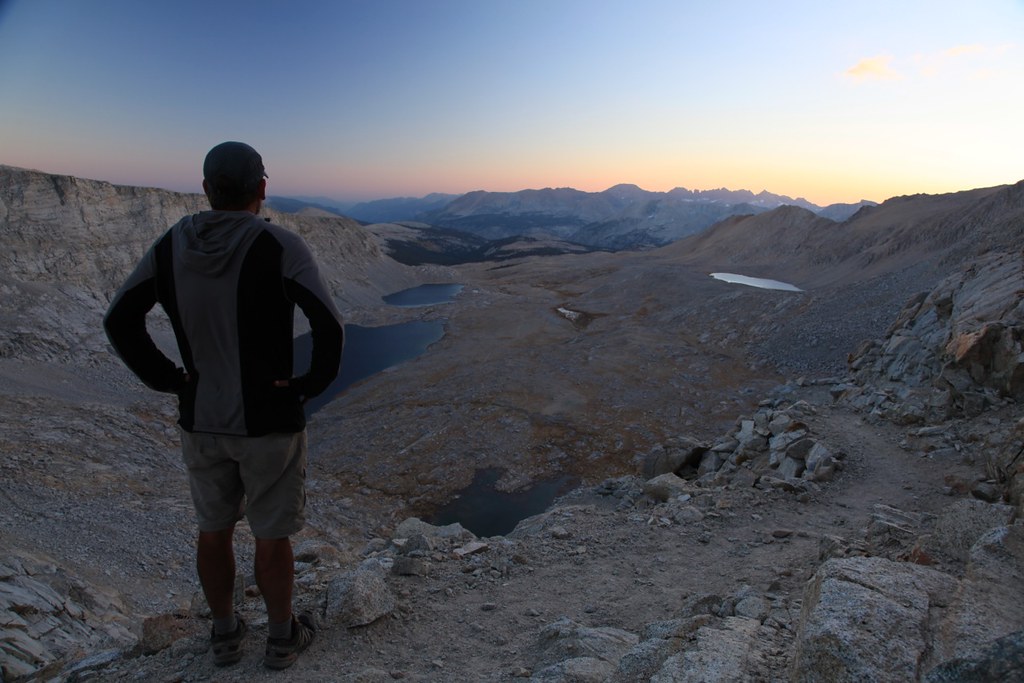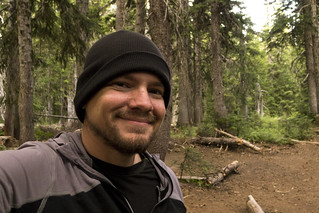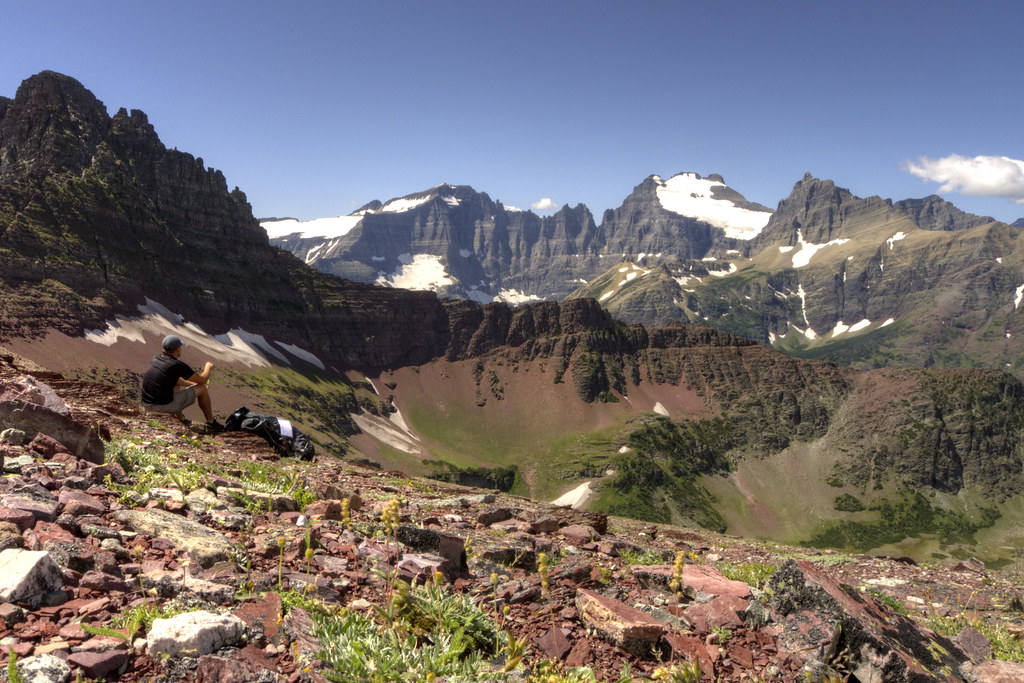 |
| (Photo: Lunch at Redgap Pass, Glacier NP, Montana) |
On a long enough hike, where you'll need to stop for supplies along the way, it can be very difficult to stick to a specific meal plan. That being said, in part two of my interview with Sports Dietitian Tavis Piattoly, I asked for specifics.
Tavis is the Sports Dietitian and Nutrition Consultant for the New Orleans Saints, New Orleans Hornets, and the Tulane University Athletic Department. He is also the co-founder and Director of Sports Nutrition education for My Sports Dietitian, as well as creator and host of the Next Level Podcast.
The difficulty in sticking to a strict meal plan is largely due to limited selection and having to carry our kitchens on our backs. Also, when it comes to food, the goal of most thru-hikers is to simply eat everything in sight in a vain attempt to avoid looking like an immunocompromised refugee in the end.
It would be difficult to convince most long distance hikers, myself included, to count every calorie and eat perfectly proportioned meals, but a perfect diet isn't necessarily my goal. Rather, it is to educate myself so I can make better food choices whether I find a fully stocked grocery store or have to resupply in a small town gas station. My ultimate goal is to improve my health, increase my energy, and maybe reduce some the aches and pains that come with long distance hiking.
So, before asking Tavis what foods we should eat, I asked what foods we should avoid.
TP: The foods you want to avoid as much as possible are very high saturated fat/fried foods as well as watching sugar intake. High saturated fat/greasy foods will promote sluggishness and foods high in sugar could create blood sugar fluctuations, especially if you consume them while taking a break in the hiking process.
There's a difference in how the body metabolizes high saturated fat rich foods (high fat beef, cheese, butter, other animal fats, etc.) versus your more mono and polyunsaturated fats, particularly those rich in Omega 3s. Nuts, Nut Butters, Olive Oil, Avocados, Fatty Fish, Fish Oil Supplements, and Flax are great sources of fat that will not make your body feel sluggish after consumption, especially when you're burning a high amount of calories during a hike.
Fried foods and high fat meats could have the opposite effect, but that doesn't mean to completely avoid them. They can be consumed at night after a long hike and used as recovery along with other balanced foods (starches and veggies). I typically don't recommend high fat meats to athletes 8-12 hours before any activity due to the very slow digestion process. I'd recommend leaner meats if you do consume them or have them available (i.e. Lean deli meats).
Regarding sugar intake, I know some people have said that the “sugar crash” is a myth. Malto from WhiteBlaze.net tested this out for himself. “On a couple of occasions,” he said. “I have tried to force a sugar crash by eating no other calories for three hours other than Kool-Aid, but I had no crash. I have not been able to see any difference between high and low glycemic index carbs during exercise." What are your thoughts on this?
During activity, your body is insulin sensitive, so you probably won't see a sugar crash as the body will utilize glucose as an energy source into the muscle and liver. The blood sugar will eventually get low but you won't have that feeling of fatigue or hunger like you would when resting and then consuming a ton of sugar.
A lower glycemic approach usually includes carbohydrate, fat, or protein-rich foods with more fiber and protein. Foods like nuts, apples, veggies, peanut butter, dairy products, meat, etc. are all low glycemic foods. You can make any meal lower glycemic by combining fat, fiber, and protein as these are the three nutrients which help blood sugar stabilize and also help you stay full.
How about salt? Many meals consumed by thru-hikers are very high in sodium. Is this much of a concern for someone getting this much exercise on a regular basis? What would a healthy amount of sodium be for a long-distance hiker?
I'd have to know sweat rates and how much fluid is lost in the process. I would think you'll need a minimum of 5,000 mg per day depending on sweat loss, considering it's about 2,000 for a 2,000 calorie diet. It may be in the upper limit of 7,000-8,000 mg per day for the very high calorie hikers. I would only be concerned with someone consuming too much sodium if they had a medical issue that requires them to be on a lower sodium diet (heart or kidney disease, high blood pressure, family history of stroke).
With our limited access to produce, should we be taking a multivitamin or other supplementation?
There could be a ton of nutrient deficiencies here since fruit and veggie intake are lower than normal considering they are low calorie foods. Using nutrient rich starches (potatoes, sweet potatoes), wheat germ, and fortified cereals could be extremely helpful. Many of the powdered protein carbohydrate bars are fortified with Vitamins but it would be a good idea to take a Multivitamin to get some additional nutrients you are not getting with food.
You could also look at using a Fruit and Veggie Powder that could assist with getting antioxidants and nutrients you would not be getting from food. It could be added to high calorie powered. Mix in and shake up with water.
Other supplements to consider to help with Immune Health are: L-Glutamine (10 grams per day), N-Acetyl Cysteine (1200 mg per day), and Fish Oil Capsules for inflammation (2000 mg or 2 g per day).
When we are out of energy between meals, what snacks are going to help get us up the next mountain?
Calorie dense snacks like Peanut Butter, Nuts, and Trail Mixes are best to spare glycogen and help you utilize some fat stores, but also mix this with dried fruits (dates, prunes, raisins).
Nutrition Bars like Clif Bars, Clif Builders, Balance Bars, Odwalla, Luna, and Lara Bars are all good options depending on what you like. You can also use candy bars with Nuts (Snickers, Pay Day, and Peanut M&M's) for extra calories when needed. Or additional options like Fig Newtons, Beef Jerky, and Peanut Butter Rice Krispie Treats. High Fiber and High Protein Dry Cereal can also be helpful (Kashi Go Lean and Special K Protein Plus are good options here).
Do you have recommendations for foods to eat at the end of the day for recovery?
Recovery should consist of a good balance of protein and carbohydrates to help the muscles recover (protein) and to refill the gas tank (carbohydrates). Whole Grain Pasta and Quinoa would be great choices that are light and would be easy to carry along. You could even try the instant bagged brown rice. Another option is oatmeal at night as this would be light to carry several bags of instant oatmeal. The best options would be the Quaker Low Sugar or Weight Control as it's high in fiber. They have several flavors that are excellent.
Protein for you at night will be Peanut Butter, Nuts, Protein Powder, Powdered Milk, Carnation Instant Breakfast, Protein Bars, Beef Jerky or Fish if caught and cooked.
My last question for part two is one from Max Patch at WhiteBlaze.net. He asks if you can give us one sample of a day's menu.
Breakfast
2 Handfuls of Nuts or Trail Mix (your choice)
1-2 cups of Kashi Go Lean Cereal (good fiber and protein)
Dried fruit (dates, prunes, or raisins) or 1 cup of oatmeal (if you have boiled water available)
Water or Water with Electrolyte tablets (i.e. NUUN)
Snack
Clif Bar, Nature's Valley Protein Bar, Peanut M&M's, Pay Day, or Snickers Bar
Handful of Nuts
Lunch
1-2 Peanut Butter and Jelly Wraps (Can use a Large LaTortilla Wrap which is high in fiber)
1-2 handfuls of Trail Mix or Almonds (I'd recommend creating your own mix of nuts, seeds, and fruit)
Water with Electrolytes to hydrate (1-2 Nuun Tablets or The Right Stuff for sodium replacement)
Snack
1-2 scoops of Protein Powder with Powdered Milk and Water or 3 ounces of Beef Jerky
Nutrition or Protein Bar (Clif, Clif Builders, Myoplex Original, etc)
Dinner
2 cups of Whole Grain Pasta (try Barilla Plus - good fiber and protein)
Can use 1 can of tomato sauce (optional if you bring canned anything)
2 tablespoons of Peanut Butter or Protein Bar
1 cup of dried fruit (good antioxidants)
Hydrate well
I'll just add that if you don't want to carry a can of tomato sauce or paste, you could also use the peanut butter to make Peanut Butter Noodles (one of my favorite backpacking meals.) To make the sauce, just mix together a serving of crunchy peanut butter, olive oil, a pinch of salt, and a little bit of the water left over from boiling the whole grain pasta. So good... but I'll talk more about meal ideas in a future post.
In the third and final part to this interview, we'll talk more about foods that prevent and cause inflammation, binge eating episodes (maintaining a calorie deficit on the trail then gorging in towns), and what we should eat while in town. I'm really hoping he says McDonald's with a side of Duncan Donuts. Keep your fingers crossed!
Thank you once again Tavis for offering your expert advice. Click here to read part three of our interview where we talk about the best town foods and binge eating episodes. If you'd like to read part one of this interview, please click here. If you have any other questions or comments, please include them in the comments section below.
- - -
Tavis Piattoly, MS, RD, LDN is the Sports Dietitian and Nutrition Consultant for the New Orleans Saints, New Orleans Hornets, and the Tulane University Athletic Department where he coordinates nutritional assessments, provides nutrition education, and develops individual meal plans for athletes to improve their health, performance, and recovery. In addition, he consults for numerous high schools athletic programs throughout the state of Louisiana. Futhermore, Tavis worked closely with Roy Jones Jr. and Bernard Hopkins to help them retain their boxing titles and has been working with Lance Berkman since 2011.
He is also the co-founder and Director of Sports Nutrition education for My Sports Dietitian (www.mysportsd.com), an online sports nutrition education company to help High School and College Athletes improve their eating habits to enhance performance, recovery, and health through the guidance of a Licensed Sports Dietitian.
Tavis obtained a Master’s of Science Degree in Exercise Physiology from Louisiana State University and a Bachelors of Science Degree in Nutrition and Dietetics from Louisiana State University. He is a registered and licensed Dietitian/Nutritionist. In addition, he serves on the Louisiana High School Athletic Association Sports Medicine Advisory Board.
Related Articles:
Part One: Nutrition for Thru-hikers: An Interview with Sports Dietitian, Tavis Piattoly
Part Three: Nutrition for Thru-hikers: An Interview with Sports Dietitian, Tavis Piattoly
Cooking Supplies and How to Make an Alcohol Stove
He is also the co-founder and Director of Sports Nutrition education for My Sports Dietitian (www.mysportsd.com), an online sports nutrition education company to help High School and College Athletes improve their eating habits to enhance performance, recovery, and health through the guidance of a Licensed Sports Dietitian.
Tavis obtained a Master’s of Science Degree in Exercise Physiology from Louisiana State University and a Bachelors of Science Degree in Nutrition and Dietetics from Louisiana State University. He is a registered and licensed Dietitian/Nutritionist. In addition, he serves on the Louisiana High School Athletic Association Sports Medicine Advisory Board.
Related Articles:
Part One: Nutrition for Thru-hikers: An Interview with Sports Dietitian, Tavis Piattoly
Part Three: Nutrition for Thru-hikers: An Interview with Sports Dietitian, Tavis Piattoly
Cooking Supplies and How to Make an Alcohol Stove
A Backpacker's Life by Ryan Grayson is licensed under a
Creative Commons Attribution-NonCommercial-NoDerivs 3.0 Unported License.
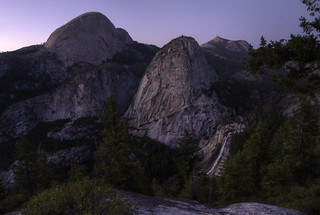
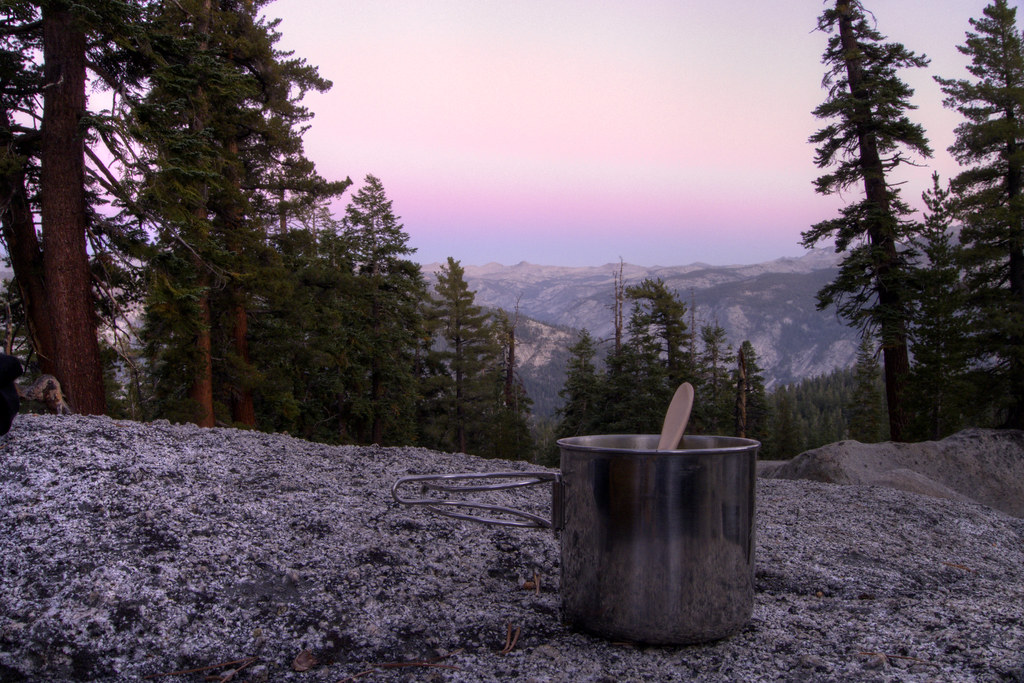
com-s.jpg)
com-s.jpg)
com-s.jpg)
com-s.jpg)
